Marksta
Shared posts
Relativity
MarkstaHaven't listened to this yet but Martin Rees and Roger Penrose really know their stuff. Should be interesting.
The Midnight Table: A Forgotten Dream

THE MIDNIGHT TABLE
I had a dream about a black, midnight table.
The table was big, not too big, but big enough. Big enough for what? Big enough for everything. And it was black. It was speckled with little stars and felt warm and smooth to the touch. I was sitting alone at it, and I can remember looking at the empty chairs and smiling.
I was waiting for people to sit down at this beautiful Midnight table.
(more…)
34 Essential Sex Tips: NEVER DON'T HAVE SEX AGAIN

Now that More Magazine has been closed, it falls to enthusiastic amateurs to give teenage ladies their sexy tips.
SHOTGUN!
1/ Cover a part of your body with a serviette. Roughly 75% of the way through your steamy sesh, whip off the serviette and say “there’s another bit for ya“.
2/ Tug at his balls with your teeth, growling. If he asks you to stop, bark enthusiastically like you think it’s a game.
3/ During your horny romp, hold a cup filled with coloured water – and try not to spill a drop!
4/ Initiate an impromptu ding-dong on the conveyor belt at the supermarket checkout. If you’re feeling super naughty, tattoo the barcode for Kellogg’s Honey Nut Crunch onto your buttock. When (if) CRUNCHY NUT FLAKES appears on the display, act like the till has said it out loud, and reply “You can get a cream for that!” then wink at the camera.
5/ Size does matter! If you discover that your fella packs less than fourteen inches, fall into a sullen melancholy, and finish yourself off with a wine bottle.
6/ Pop a clarinet reed into his dickpipe, and play him to completion!
7/ Create a sense of mysterious allure by closing your eyes! Double the compelling mystique by demanding “WHO THE HELL IS THIS?”
8/ Grab a balloon from the family-friendly world cuisine restaurant Giraffe, and allow it deflate into your sodden mum-hoop. Let your lover know you’re ready for sex by allowing the stagnant air to barrel out of your goop in a prolonged, fusty queef!
9/ Introduce a new bit of sexy clothing into the bedroom. Three words: crotchless oilskin sou’westers.
10/ Get retro! Hurl a palmful of centimetre cubes into his face mid-climax, and say “Mister! You’re spunking big pixels into my bidoof”

11/ Lie flat on your back, and let him use your body as the location for an exciting Warhammer tabletop skirmish. Don’t ruin it by bouncing your tummy up and down and saying it’s an Earthquake – it’s not funny it’s stupid stop it.
12/ Involve yourself in his fantasies! When he’s having a wank, run in with a bone-chilling battlecry and try to land on his dick!
13/ Learn his intimate secrets by rooting around in his internet history and saying you’ll tell the police if he doesn’t see a psychologist!
14/ Add a little exotic spice into your love life by slapping your hand over your open mouth to make a popping sound, and whispering “Ooga Booga” into his ear when he leans in for a kiss.
15/ Don’t be afraid to laugh in the bedroom – pop a “Family Guy In Your Pocket” key-ring into your vajongloid and generate chuckle convulsions on every thrust of his pee-wee!
1/ Cup the balls and work the shaft
2/ Jam a knuckle into the taint
3/ Thump your forehead against his choad
4/ Wank him off behind a butler
5/ Explode his groin with focussed sunlight
16/ Break some taboos! Finger a strip of raw veal into his arsehole.
17/ Indulge in some kinky power-play by sporting a 10 inch strap-on, and drafting legislation that restricts his free speech in a state of national emergency.
18/ Bored of the bedroom? Add a little archaic flavour to your repertoire by cramming half a dozen wangs into your plap in the scullery. Don’t get your Labi Siffre snagged in the mangle!
19/ No condoms? Slide an empty can of beans into your mouth for a imperfect but effective dental dam.
20/ Why not leave the beans in the tin? It’ll be like he’s tooting some breakfasty guts.
21/ Tired? Let plate tectonics do all the hard work! Lie across your favourite fault line, and wait millenia for the earth’s shifting crust to contort your naked bodies into every sex position known to geography.
22/ Get closer to nature by placing a beetle in your hair.
23/ Try out one of our Positions of the Fortnight! We call this one “A Wanking Pink Guy”
24/ They say the way to a man’s heart is through his stomach. This couldn’t be more wrong! The way to a man’s heart is out of his winkle and onto a tea towel.
25/ A well-placed skateboard can create the sexy illusion that you are floating, gliding, and accelerating down a hill.
26/ Before foreplay, warm a boob on the radiator.
27/ As Fleetwood Mac said: tell me lies, tell me sweet little lies, tell me lies (tell me tell me lies). They would have been alarmed to hear Charles and Eddie sing Would I lie to you baby?, as the implication from the way the question was put was that it was a rhetorical question, and the pre-ordained answer was an emphatic “no!”
Now imagine Fleetwood Mac’s relief when Meatloaf walks in, singing I Would Lie For You! And then the relief gives way to confusion when he adds (And That’s A Fact). And a couple of seconds later, Fleetwood Mac realised that it wasn’t a paradox at all, and the two statements are very easily reconciled. The moral of the story is: Fleetwood Mac and Meatloaf immediately went on to do it (sex).
28/ Kiss him on the shins, and keep going until he suggests you do something else, or asks you to stop.
29/ Add a bit of European flavour to your lovemaking by whacking snails across a work surface with a boiled sausage.
We can’t let the vital sex tips industry die. Have you got any sizzling sex attacks that you employ on the genitals of your partner?
Tip 21 courtesy of @misterbrilliant‘s residential sexmastery course
Longest Sunset
Longest Sunset
What is the longest possible sunset you can experience while driving, assuming we are obeying the speed limit and driving on paved roads?
—Michael Berg
To answer this, we have to be sure what we mean by “sunset".
This is a sunset:

This is not a sunset:

For the purposes of our question, this is not a sunset:

This is also not a sunset:

This is definitely not a sunset:

And no matter what happens here, this will not be a sunset:

Sunset starts the instant the Sun touches the horizon, and ends when it disappears completely. If the Sun touches the horizon and then lifts back up, the sunset is disqualified.
For a sunset to count, the Sun has to set behind the idealized horizon, not just behind a nearby hill. This is not a sunset, even though it seems like one:

The reason that can’t count as a sunset is that if you could use arbitrary obstacles, you could cause a sunset whenever you wanted by hiding behind a rock.
Note: We also have to consider refraction. The Earth’s atmosphere bends light, so when the Sun is at the horizon it appears about one Sun-width higher than it would otherwise. The standard practice seems to be to include the average effect of this in all calculations, which I’ve done here.
At the Equator in March and September, sunset is a hair over two minutes long. Closer to the poles, in places like the London, it can take between 200 and 300 seconds. It’s shortest in spring and fall (when the Sun is over the equator) and longest in the summer and winter.
If you stand still at the South Pole in early March, the Sun stays in the sky all day, making a full circle just above the horizon. Sometime around March 21st, it touches the horizon for the only sunset of the year. This sunset takes 38-40 hours, which means it makes more than a full circuit around the horizon while setting.
But Michael’s question was very clever. He asked about the longest sunset you can experience on a paved road. There’s a road to the research station at the South Pole, but it’s not paved—it’s made of packed snow. There are no paved roads anywhere near either pole.
The closest road that really qualifies is probably the main road in Longyearbyen, on the island of Svalbard, Norway. (The end of the airport runway in Longyearbyen gets you slightly further, although driving there might get you in trouble.)
Longyearbyen is actually closer to the North Pole than McMurdo Station in Antarctica is to the South Pole. There are a handful of military, research, and fishing stations further north, but none of them have much in the way of roads; just airstrips, which are usually gravel and snow.
If you putter around downtown Longyearbyen (get a picture with the “polar bear crossing” sign), the longest sunset you could experience would be a few minutes short of an hour. It doesn’t actually matter if you drive or not; the town is too small for your movement to make a difference.
But if you head a little ways south, you can do even better.
If you start driving from the tropics and stay on paved roads, the furthest north you can get is the tip of European Route 69 in Norway. There are a number of roads crisscrossing northern Scandinavia, so that seems like a good place to start. But which road should we use?
Intuitively, it seems like we want to be as far north as possible. The closer we are to the pole, the easier it is to keep up with the Sun.
Unfortunately, it turns out keeping up with the Sun isn’t a good strategy. Even in those high Norwegian latitudes, the Sun is just too fast. At the tip of European Route 69—the farthest you can get from the Equator while driving on paved roads—you’d still have to drive at about half the speed of sound to keep up with the Sun. (And E69 runs north-south, not east-west, so you’d drive into the Barents Sea anyway.)
Luckily, there’s a better approach.
If you're in northern Norway on a day when the Sun just barely sets and then rises again, the terminator (day-night line) moves across the land in this pattern:

(Not to be confused with the Terminator, which moves across the land in this pattern:)

To get a long sunset, the strategy is simple: Wait for the date when the terminator will just barely reach your position. Sit in your car until the terminator reaches you, drive north to stay a little ahead of it for as long as you can (depending on the local road layout), then u-turn and drive back south fast enough that you can get past it to the safety of darkness. (These instructions also work for the other kind of Terminator.)
Surprisingly, this strategy works about equally well anywhere inside the Arctic Circle, so you can get this lengthy sunset on many roads across Finland and Norway. I ran a search for long-sunset driving paths using PyEphem and some GPS traces of Norwegian highways. I found that over a wide range of routes and driving speeds, the longest sunset was consistently about 95 minutes—an improvement of about 40 minutes over the Svalbard sit-in-one-place strategy.
But if you are stuck in Svalbard and want to make the sunset—or sunrise—last a little longer, you can always try spinning counterclockwise. It’s true that it will only add an immeasurably small fraction of a nanosecond. But depending on who you’re with ...

... it might be worth it.
The Big Book of Bluffing (Netrunner)
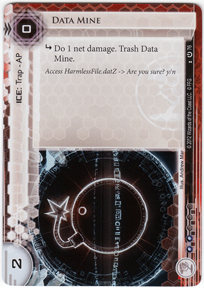
Not that kind of trap
A Corp in Netrunner is in a fairly unique position for a CCG. In most card games, the uncertainty comes from the cards in the opponent’s deck and their cards in their hand. A few card games also have some face-down traps, which put a little guessing into the game. But in Netrunner, every card you play that enters play does so face down, giving you massive bluffing potential. In addition, the only way the runner can really win the game is by braving your face-down ICE and Traps and hopefully snagging enough agendas to win. So obviously, there’s a massive amount of bluffing in this game for the Corp.
But since this is fairly unique to Netrunner, a lot of people don’t really know what to do when they’re given this access to bluff. Many people don’t know what to do with this great bluffing potential, as it’s not something you run into in most games. They want those shiny traps to hit, but they don’t know how to make it work. It seems like every time they play a trap, the opponent seems to know, and just avoids it.
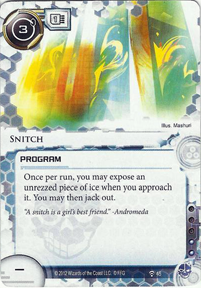 Don’t worry; it’s not actually that hard. I’m going to lay down a couple of guidelines for when and how make your bluffs believable, and a couple of bluffing philosophies. Next, we’ll talk about the differences between traps with different numbers of tokens on them. Then, I’ll go into some detail on how to play around Infiltration, how to take advantage of predictability in your local metagame. Then, we’ll look at the other side of the coin and discuss how to beat your opponent’s bluffs. Finally, I’ll briefly discuss more unorthodox advancement patterns and why I don’t think they’re worth the trouble.
Don’t worry; it’s not actually that hard. I’m going to lay down a couple of guidelines for when and how make your bluffs believable, and a couple of bluffing philosophies. Next, we’ll talk about the differences between traps with different numbers of tokens on them. Then, I’ll go into some detail on how to play around Infiltration, how to take advantage of predictability in your local metagame. Then, we’ll look at the other side of the coin and discuss how to beat your opponent’s bluffs. Finally, I’ll briefly discuss more unorthodox advancement patterns and why I don’t think they’re worth the trouble.
(This article will not cover the concepts of physical tells, like nervous tics, false tells, or anything else like that. Those kinds of things vary greatly from person to person, and are really outside the scope of this article. There is something to be gained in studying this, though, and if you really want to dive down that rabbit hole, there’s a lot of information online about reading physical tells.)
Sell your traps as if they were agendas
The most important point to make is that your traps will never catch the opponent if you don’t sell them on the idea that it’s actually an agenda or an upgrade. A trap with a couple of advancement tokens on it which sits there for 3 turns isn’t going to fool anyone… Who leaves an agenda sitting around with 2 or 3 tokens on it?
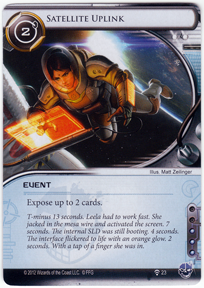 Also, the idea of playing your traps and agendas unprotected as if they were kind of a shell game doesn’t really work out that well. Installing assets into a ton of remote servers with no ICE on them and advancing random cards falls apart if the opponent plays intelligently. If your opponent only runs when they have enough cards in hand to eat a trap, then they’ll be able to run those servers with near impunity, and their ability to make 2 or 3 runs a turn will quickly outstrip your ability to lay traps and put enough tokens on them to be effective. (Wyldside in particular really hurts this strategy, and that card sees very heavy play.) And if they play Infiltration or Satellite Uplink then you’re just totally hosed.
Also, the idea of playing your traps and agendas unprotected as if they were kind of a shell game doesn’t really work out that well. Installing assets into a ton of remote servers with no ICE on them and advancing random cards falls apart if the opponent plays intelligently. If your opponent only runs when they have enough cards in hand to eat a trap, then they’ll be able to run those servers with near impunity, and their ability to make 2 or 3 runs a turn will quickly outstrip your ability to lay traps and put enough tokens on them to be effective. (Wyldside in particular really hurts this strategy, and that card sees very heavy play.) And if they play Infiltration or Satellite Uplink then you’re just totally hosed.
 So how exactly do we play our traps and actually get the opponent to fall for them? You probably won’t be surprised to know that we can steal a good lesson from poker. In one of the bibles of Poker, ‘The Theory of Poker’ by David Sklansky, he describes how strong poker play must involve bluffs to keep the opponent from knowing your intentions every time you bet. He says that you should not be on the lookout for situations in which to bluff, but instead that you should try to mix in your pure bluffs randomly, and should play them in the same way as you play your legitimate hands. A large portion of this information applies very well to Netrunner. (Really, I could practically write an entire article applying things from this book to Netrunner, it’s an amazing book.)
So how exactly do we play our traps and actually get the opponent to fall for them? You probably won’t be surprised to know that we can steal a good lesson from poker. In one of the bibles of Poker, ‘The Theory of Poker’ by David Sklansky, he describes how strong poker play must involve bluffs to keep the opponent from knowing your intentions every time you bet. He says that you should not be on the lookout for situations in which to bluff, but instead that you should try to mix in your pure bluffs randomly, and should play them in the same way as you play your legitimate hands. A large portion of this information applies very well to Netrunner. (Really, I could practically write an entire article applying things from this book to Netrunner, it’s an amazing book.)
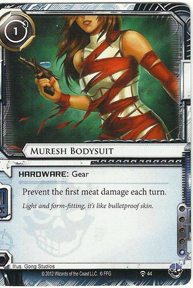 So, following this advice, we’re going to play our traps exactly as if they were agendas or upgrades. We’re not going to give up information by only playing our traps in under-defended servers, only in certain situations, and so on. We’re going to pick a strategy to use for playing all our cards into our servers, and use it for both our agendas and traps to make sure that we’re not letting anything slip when we try to trick the opponent. In addition, we are going to try to mix in our bluffs as randomly as we can. (With a few exceptions where bluffs have very low expectation due to the rules or the game… Those situations will be noted below.)
So, following this advice, we’re going to play our traps exactly as if they were agendas or upgrades. We’re not going to give up information by only playing our traps in under-defended servers, only in certain situations, and so on. We’re going to pick a strategy to use for playing all our cards into our servers, and use it for both our agendas and traps to make sure that we’re not letting anything slip when we try to trick the opponent. In addition, we are going to try to mix in our bluffs as randomly as we can. (With a few exceptions where bluffs have very low expectation due to the rules or the game… Those situations will be noted below.)
Playing things randomly is something we can get out of the way quickly. We don’t always have the option to bluff randomly, because we are required to have certain cards in your hand in order to lay a trap. But if you have the option to play a trap or an agenda and you want to do so randomly, you can use any number of randomizers, like a watch, a scentence from your favorite book, and so on. Exactly how often to bluff is too complex for this entry-level article, and something which I have not researched enough to comment on, but I might look into that later.
As for the more complex issue of playing things the same and how exactly to play your traps and agendas, read on.
Over-Protect everything or Under-Protect everything?
 Now that we know that the traps only work if we play our traps and our agendas in the same way, we’re led to the next obvious question… How should we play all our agendas and traps? There are two basic schools of thought here. One is to protect everything and make sure that it’s difficult for your opponent to access your traps and your agendas. The other is to protect everything a little more lightly than you otherwise would, and rely on the fact that you’re playing some traps to provide your extra protection.
Now that we know that the traps only work if we play our traps and our agendas in the same way, we’re led to the next obvious question… How should we play all our agendas and traps? There are two basic schools of thought here. One is to protect everything and make sure that it’s difficult for your opponent to access your traps and your agendas. The other is to protect everything a little more lightly than you otherwise would, and rely on the fact that you’re playing some traps to provide your extra protection.
In over-protecting everything, you’re making it look like it’s always going to be difficult to get in, and there may still be a trap waiting for them after they spend 10 credits to get in. The basic idea here is that it’s the safest way of bluffing. You’re trading ease of access for your traps away in order to make it more difficult and more expensive for your opponent to run away with an agenda.
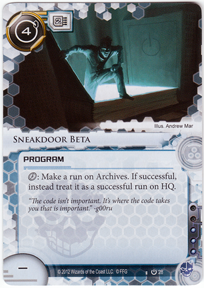 On the plus side for this strategy, it’s fairly resistant to Infiltration and other peeking abilities. A server which is difficult to access serves as a second layer of protection if your opponent peeks and realizes that there’s an agenda in the server. You’re essentially using your ICE as a backup plan, just in case your opponent picks up a tell or peeks at the card in the server. And of course, if your opponent thinks they’re outsmarting you or tricking you by playing that Inside Job they splashed in, then they’re probably very much caught off-guard by a trap they’re not expecting, and there’s a greater chance that they weren’t prepared for it. A problem with this strategy is that sometimes your traps are going to fail just because the opponent will be too scared to run. If you’ve got a server with three pieces of ICE and a fourth unrezzed one on top, he might just decide he’s unlikely to be able to run that server, and all you’ve done is waste a turn.
On the plus side for this strategy, it’s fairly resistant to Infiltration and other peeking abilities. A server which is difficult to access serves as a second layer of protection if your opponent peeks and realizes that there’s an agenda in the server. You’re essentially using your ICE as a backup plan, just in case your opponent picks up a tell or peeks at the card in the server. And of course, if your opponent thinks they’re outsmarting you or tricking you by playing that Inside Job they splashed in, then they’re probably very much caught off-guard by a trap they’re not expecting, and there’s a greater chance that they weren’t prepared for it. A problem with this strategy is that sometimes your traps are going to fail just because the opponent will be too scared to run. If you’ve got a server with three pieces of ICE and a fourth unrezzed one on top, he might just decide he’s unlikely to be able to run that server, and all you’ve done is waste a turn.
In under-protecting everything, you’re leaving your servers a bit easier to access, so your opponent likely knows that he can get into a server, but he also knows that it may be a trap. This way of playing is slightly more consistent with the philosophy of playing traps; we don’t need to protect our servers quite as heavily when we have the added protection of traps.
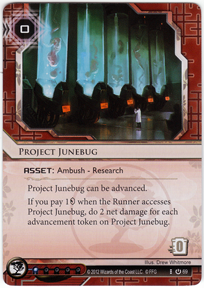 On the plus-side, your traps will always have a chance of hitting if your opponent knows they can likely get in. In addition, if you do this, you can either get away with running less ICE, or play the same amount of ICE and use it to protect other servers you might otherwise have to under-protect. If you only need to play three pieces of ICE on your remote server because you are expecting traps to scare the opponent, then you might be able to afford that extra piece of ICE protecting your discard pile from the Sneakdoor Beta that Gabe has out. On the downside, it’s not expensive for your opponent to try and call your bluff. If your opponent has four or five cards in hand just in case that 2-token card is a Project Junebug, then they can pretty much run your lightly-defended server with impunity. If you under-protect your servers, expect your opponent to run your servers more often, ‘just to keep you honest.’ In addition, this strategy can fall to Infiltration-type cards. If your server is relatively easy to get into, then if your opponent somehow knows there’s an agenda in there, then it’s simple to steal it.
On the plus-side, your traps will always have a chance of hitting if your opponent knows they can likely get in. In addition, if you do this, you can either get away with running less ICE, or play the same amount of ICE and use it to protect other servers you might otherwise have to under-protect. If you only need to play three pieces of ICE on your remote server because you are expecting traps to scare the opponent, then you might be able to afford that extra piece of ICE protecting your discard pile from the Sneakdoor Beta that Gabe has out. On the downside, it’s not expensive for your opponent to try and call your bluff. If your opponent has four or five cards in hand just in case that 2-token card is a Project Junebug, then they can pretty much run your lightly-defended server with impunity. If you under-protect your servers, expect your opponent to run your servers more often, ‘just to keep you honest.’ In addition, this strategy can fall to Infiltration-type cards. If your server is relatively easy to get into, then if your opponent somehow knows there’s an agenda in there, then it’s simple to steal it.
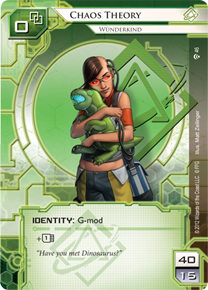 There’s no right answer to how to play your traps, as long as you’re playing your traps and agendas in the same way. Under-Protecting and Over-Protecting are both fine, as long as you’re doing it in a way which doesn’t give your opponent any information. You can play safer against Criminal decks which are likely to have Satellite Uplink, and riskier against a Chaos Theory deck which doesn’t have enough space for such niceties. You can even start off under-protecting, and then over-protect after your opponent uses their first infiltration to spot a trap. Under-Protecting versus Over-Protecting is not a scale of correctness; it’s a scale of riskiness.
There’s no right answer to how to play your traps, as long as you’re playing your traps and agendas in the same way. Under-Protecting and Over-Protecting are both fine, as long as you’re doing it in a way which doesn’t give your opponent any information. You can play safer against Criminal decks which are likely to have Satellite Uplink, and riskier against a Chaos Theory deck which doesn’t have enough space for such niceties. You can even start off under-protecting, and then over-protect after your opponent uses their first infiltration to spot a trap. Under-Protecting versus Over-Protecting is not a scale of correctness; it’s a scale of riskiness.
So now that we have a good idea of how we are going to play our traps, let’s look at some specifics about each type of trap you can play and how you can trick people with them.
Assets without Advancement Tokens
There’s something to be said for traps and assets which you can’t install tokens on. These traps only take one click to lay down, and they work without any extra investment. They don’t usually kill the opponent, but are very low risk, and they also have the most bluffing potential by a long shot.
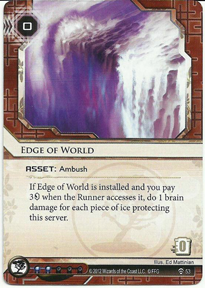 Traps which work without agenda tokens have a subtle advantage over the ones which do. They can sometimes sit in servers for a very large number of turns without being suspicious, because of multitude of options they can represent. For example, if I install an Edge of the World into a server, I am attempting to pass it off as a 3-point agenda which I will score next turn. If the opponent does not access it on that turn, though, it does not look as suspicious for me to leave it in the server. In fact, even if I leave it in a server for two or three turns, it regains its threatening potential once again if I install an upgrade into the server, like Akitaro Watanabe or Corporate Troubleshooter. Now it looks like my original trap which has been sitting there untriggered was the protective upgrade, and the second card is finally my attempt to put an agenda into the server.
Traps which work without agenda tokens have a subtle advantage over the ones which do. They can sometimes sit in servers for a very large number of turns without being suspicious, because of multitude of options they can represent. For example, if I install an Edge of the World into a server, I am attempting to pass it off as a 3-point agenda which I will score next turn. If the opponent does not access it on that turn, though, it does not look as suspicious for me to leave it in the server. In fact, even if I leave it in a server for two or three turns, it regains its threatening potential once again if I install an upgrade into the server, like Akitaro Watanabe or Corporate Troubleshooter. Now it looks like my original trap which has been sitting there untriggered was the protective upgrade, and the second card is finally my attempt to put an agenda into the server.
In fact, you can even use non-trap assets as traps on occasion. While traps usually cost the 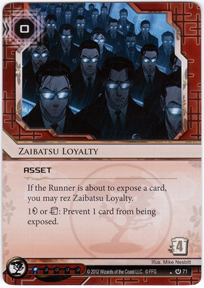 opponent cards in hand or installed programs, a harmless asset costs credits. For example, in a recent game, I was at 5 points playing Jinteki, and had a reasonably well-protected server, but one which the opponent could get through at a high cost. (About 10 credits) This was something that both of us knew, all the ICE was face-up. Nothing was going to change the fact that he could access that server. But the risk of me scoring immediately pretty much meant he had to run the server and try and stop it, no matter what I put in. My opponent was prepared for the worst, with a Wyldside in play keeping his hand big enough to stop any crazy traps from killing him. So I simply played a Zaibatsu Loyalty into that server and next turn, my opponent paid 10 gold to make sure it wasn’t a Braintrust and I couldn’t win next turn. If Zaibatsu Loyalty’s card text said, “Next turn, your opponent loses one click and ten credits” I would play it all day long. And if he didn’t access it, I wouldn’t feel too bad about just trashing it and trying again later after installing some more ICE and making him guess again.
opponent cards in hand or installed programs, a harmless asset costs credits. For example, in a recent game, I was at 5 points playing Jinteki, and had a reasonably well-protected server, but one which the opponent could get through at a high cost. (About 10 credits) This was something that both of us knew, all the ICE was face-up. Nothing was going to change the fact that he could access that server. But the risk of me scoring immediately pretty much meant he had to run the server and try and stop it, no matter what I put in. My opponent was prepared for the worst, with a Wyldside in play keeping his hand big enough to stop any crazy traps from killing him. So I simply played a Zaibatsu Loyalty into that server and next turn, my opponent paid 10 gold to make sure it wasn’t a Braintrust and I couldn’t win next turn. If Zaibatsu Loyalty’s card text said, “Next turn, your opponent loses one click and ten credits” I would play it all day long. And if he didn’t access it, I wouldn’t feel too bad about just trashing it and trying again later after installing some more ICE and making him guess again.
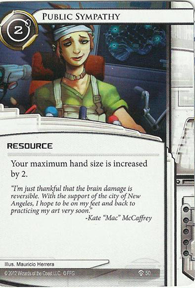 The real killer trap here is Edge of the World. Brain damage really hurts, and makes your future traps even more threatening. But since it has to be in a server which has ICE in front of it, you pretty much have to install it in your main remote server, and pass it off as an agenda or an upgrade. Snare is a great surprise, but there’s a big benefit to just keeping it in your hand and trying to punish people for accessing that. (Although passing off a Snare as an unprotected Pad Campaign very early game can work pretty well.)
The real killer trap here is Edge of the World. Brain damage really hurts, and makes your future traps even more threatening. But since it has to be in a server which has ICE in front of it, you pretty much have to install it in your main remote server, and pass it off as an agenda or an upgrade. Snare is a great surprise, but there’s a big benefit to just keeping it in your hand and trying to punish people for accessing that. (Although passing off a Snare as an unprotected Pad Campaign very early game can work pretty well.)
Bluffing with 1 or 2 advancement tokens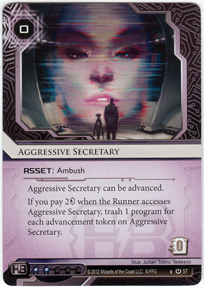 Assets which require advancement tokens to work (like Project Junebug or Aggressive Secretary) are much more straight-forward. When you install a trap like this, you are attempting to convince your opponent that it is a 4 or 5 cost agenda that you will score next turn if they do not stop you. If you fool the opponent and they access your trap, you will probably get a nice payoff, which, in the case of two tokens, is probably greater than the traps which you can’t advance. If the opponent doesn’t run them, you just wasted a couple of credits and clicks, and it’s time to trash them and install something else, starting the guessing game again. That’s the biggest issue with these traps. They take so much setup that it’s pretty painful if the opponent does not fall for them. If I install and Aggressive Secretary and advance it twice and the opponent doesn’t run it, then I’ve wasted an entire turn.
Assets which require advancement tokens to work (like Project Junebug or Aggressive Secretary) are much more straight-forward. When you install a trap like this, you are attempting to convince your opponent that it is a 4 or 5 cost agenda that you will score next turn if they do not stop you. If you fool the opponent and they access your trap, you will probably get a nice payoff, which, in the case of two tokens, is probably greater than the traps which you can’t advance. If the opponent doesn’t run them, you just wasted a couple of credits and clicks, and it’s time to trash them and install something else, starting the guessing game again. That’s the biggest issue with these traps. They take so much setup that it’s pretty painful if the opponent does not fall for them. If I install and Aggressive Secretary and advance it twice and the opponent doesn’t run it, then I’ve wasted an entire turn.
These traps have their best chance of ‘trapping’ the opponent when they are dropped and advance them once or twice immediately, because that looks so unsuspicious. But once you advance them, they basically have a one-turn window to fool the opponent, because nobody leaves partially-scored agendas sitting around if they can 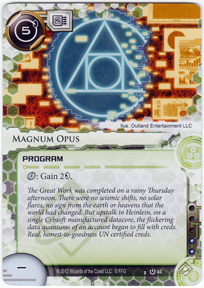 help it. You might be able to drop the asset on one turn and then advance it on another turn, but that starts to look a little suspicious. You might be able to sell it if your remote server is much more protected than your hand and it looks like you’re installing it there for safety. And, of course, if the runner accesses these assets with no tokens, then they don’t get trapped, but they waste the money to access the server, which is a nice return on the investment. (But it lacks the subtle pleasure of yanking four cards out of the opponent’s hand.)
help it. You might be able to drop the asset on one turn and then advance it on another turn, but that starts to look a little suspicious. You might be able to sell it if your remote server is much more protected than your hand and it looks like you’re installing it there for safety. And, of course, if the runner accesses these assets with no tokens, then they don’t get trapped, but they waste the money to access the server, which is a nice return on the investment. (But it lacks the subtle pleasure of yanking four cards out of the opponent’s hand.)
At one advancement token, Aggressive Secretary stands out. With only one token, Project Junebug just tickles the opponent a bit, which Aggressive Secretary can get rid of a key Magnus Opus or Yog-a-saurus. With two tokens, Project Junebug really starts shining, as losing four cards is really painful. (If not outright deadly.)
Bluffing with more than two advancement tokens
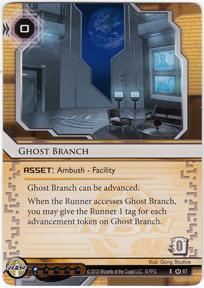 Here’s where things get silly. Traps with more than 2 advancement tokens are a much rarer scenario, as they usually represent an investment of more than one turn into tricking the opponent. It can be incredibly costly if these traps fail, but of course, the payoff is huge. A three-token Project Junebug kills just about any runner, and a three token Aggressive Secretary can practically wipe the runner’s whole rig. (And a three-token Ghost Branch… tags them three times.) And like the other examples, if the trap is accessed the turn you laid it down with no tokens on it, then you’re presumably draining the runner’s credits.
Here’s where things get silly. Traps with more than 2 advancement tokens are a much rarer scenario, as they usually represent an investment of more than one turn into tricking the opponent. It can be incredibly costly if these traps fail, but of course, the payoff is huge. A three-token Project Junebug kills just about any runner, and a three token Aggressive Secretary can practically wipe the runner’s whole rig. (And a three-token Ghost Branch… tags them three times.) And like the other examples, if the trap is accessed the turn you laid it down with no tokens on it, then you’re presumably draining the runner’s credits.
But if you want the big payoff, the big issue is to actually convince the opponent that the card with three tokens on it is an agenda. This is difficult; the only agendas which really make sense to play in this way are Mandatory Upgrades, and agendas like Project Atlas or Project Vitruvius which can be advanced beyond the amount they need to be scored. (And 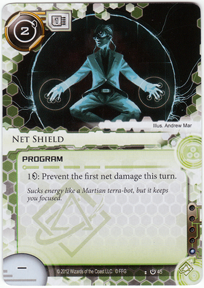 really, three or so tokens is kind of a practical limit to how many tokens you can put on a card before the opponent gets suspicious. After you fish out your Sea Source and your two Scorched Earths, how many other cards do you need to get out of your deck with Project Atlas, anyway?)
really, three or so tokens is kind of a practical limit to how many tokens you can put on a card before the opponent gets suspicious. After you fish out your Sea Source and your two Scorched Earths, how many other cards do you need to get out of your deck with Project Atlas, anyway?)
If your opponent sees that you’re running these kinds of cards, then you’re good. For example, if he steals a Project Atlas from you, then he knows there’s potential for it to pop up and be advanced more than three times. But think about the story you’re trying to sell the opponent. If they stole your first Project Atlas and it looks like you’re desperate to fish out those pieces of the Scorched Earth combo a few turns later, then that looks believable. If the opponent has seen both a Sea Source and a Scorched Earth by accessing your hand, are they really going believe you need more cards from Project Atlas?
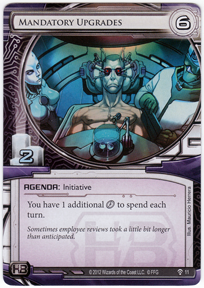 This is the main reason I like to play Mandatory Upgrades in HB. It gives me the ability to really sell a Project Junebug with three tokens on it as if it were an agenda. If I score one, if definitely doesn’t preclude me from trying to score another. And aside from the obvious benefits of scoring it, it makes laying down an asset/agenda and immediately giving it three tokens on the same turn a very reasonable course of action; it looks like I want to score another Mandatory Upgrades. So we can make it look like we have a valid reason to have 3-token agendas multiple times in a game, which really helps to make those game-ending traps land.
This is the main reason I like to play Mandatory Upgrades in HB. It gives me the ability to really sell a Project Junebug with three tokens on it as if it were an agenda. If I score one, if definitely doesn’t preclude me from trying to score another. And aside from the obvious benefits of scoring it, it makes laying down an asset/agenda and immediately giving it three tokens on the same turn a very reasonable course of action; it looks like I want to score another Mandatory Upgrades. So we can make it look like we have a valid reason to have 3-token agendas multiple times in a game, which really helps to make those game-ending traps land.
But the real problem here is that some opponents simply won’t run on a card with that many tokens, ever. Here, mixing in a random bluff has a low expectation, so it’s not worth it to throw in those three-token bluffs. If you find yourself playing in that kind of environment, you can only really expect these traps to work when your opponent must run, or they just lose. You might be about to get away with feigning a big Project Atlas at any time if you’re playing Tag and Bag, since a 6-point Project Atlas gets all the points you need to kill almost anyone… But that’s really only an option for a player who is willing to devote almost all of their deck’s influence to throwing traps on top of the typical Tag and Bag setup. If you’re playing traps out of HB, you might want to consider only playing these traps when you have 5 points scored already, and another Mandatory Upgrades would win you the game.
Infiltration
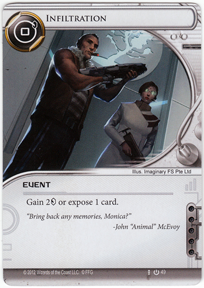 If your opponent plays cards that reveal your traps, then as we pointed out earlier in the article, you might want to swap to a more protected method of play, which makes your traps a little less likely to hit, but makes it so Infiltration doesn’t give the opponent a very cheap agenda. You can’t do anything else about it if they have Infiltration in their deck, so just keep playing the traps and agendas and mix things up like you normally would, and hopefully, you will be able to force them to take a guess without a copy of Infiltration in your hand. Smile, congratulate them on spotting your trap, and move on quickly.
If your opponent plays cards that reveal your traps, then as we pointed out earlier in the article, you might want to swap to a more protected method of play, which makes your traps a little less likely to hit, but makes it so Infiltration doesn’t give the opponent a very cheap agenda. You can’t do anything else about it if they have Infiltration in their deck, so just keep playing the traps and agendas and mix things up like you normally would, and hopefully, you will be able to force them to take a guess without a copy of Infiltration in your hand. Smile, congratulate them on spotting your trap, and move on quickly.
Your deck construction shouldn’t change because of the existence of this card in your meta-game either. If you’re playing a Jinteki deck which is relying on only traps to win, throw in Zaibatsu Loyalty (which should probably already be in the deck anyway.) If you’re playing a deck with a few traps here and there to surprise people, then just leave your deck be and tune your play a bit.
Local meta-game
If the player you are playing against or your local meta-game plays in such a way as to give up information or removes uncertainty, then you can take advantage of it. For example, I have heard a disturbing number of players in my area say that they simply refuse to run on any server which does not have an advanced card in it, for fear of it being Edge of the World. If you are a situation where you opponents will play this predictably, then there are two ways you can take advantage of the situation.
First, you can only play traps which take advancement tokens. If you only play traps like Aggressive Secretary and Project Junebug, then you’re simply tweaking your traps to make them more likely to hit these players. This will work just fine, and as we know, those traps with 2 or 3 tokens on them can be truly brutal when they hit.
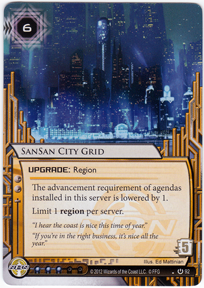 Second, you can play more agendas which can be advanced in a single turn, essentially calling their bluff. If you know that your opponent refuses to run anything without advancement tokens, then you can take advantage of this by either running more 3-cost agendas and scoring them the turn after they are installed, or by simply playing a fast-advance deck which scores agendas on the same turn they are dropped. So if you’re playing HB, for example, you might consider running both Accelerated Beta Test and Project Vitruvius. Or you might want to pull out your NBN Fast-Advance deck and never let an agenda sit on the board all game. Once you opponent catches on that you’re taking advantage of this hole in their game and starts running on un-advanced cards again, you’ll be able to play in a more regular style. And if they don’t catch on? Great, take advantage of it all day long.
Second, you can play more agendas which can be advanced in a single turn, essentially calling their bluff. If you know that your opponent refuses to run anything without advancement tokens, then you can take advantage of this by either running more 3-cost agendas and scoring them the turn after they are installed, or by simply playing a fast-advance deck which scores agendas on the same turn they are dropped. So if you’re playing HB, for example, you might consider running both Accelerated Beta Test and Project Vitruvius. Or you might want to pull out your NBN Fast-Advance deck and never let an agenda sit on the board all game. Once you opponent catches on that you’re taking advantage of this hole in their game and starts running on un-advanced cards again, you’ll be able to play in a more regular style. And if they don’t catch on? Great, take advantage of it all day long.
Beating Bluffs
So how do we beat a good bluffer? If your opponent is bluffing perfectly, then there’s nothing you can do about it. The simple answer is you can’t really BEAT them, the best you can do is make your guesses as good as 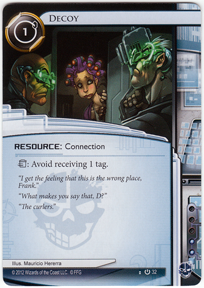 you possibly can. Since we’re playing a good bluffer and we have no tells to work with, we have to use game theory and think about risk versus reward. If we are at 5 agenda points and our opponent is at 3 agenda points, and he lays an unrezzed card in an empty server with three pieces of ICE protecting it, there are four real possibilities we need to consider:
you possibly can. Since we’re playing a good bluffer and we have no tells to work with, we have to use game theory and think about risk versus reward. If we are at 5 agenda points and our opponent is at 3 agenda points, and he lays an unrezzed card in an empty server with three pieces of ICE protecting it, there are four real possibilities we need to consider:
- It’s a Snare
- It’s an Edge of the World
- It’s an Agenda
- It’s some upgrade or unadvanced trap.
If we have no other information about what could be in server, then we have to make an educated guess about whether or not to run it. If we had all the time in the world, we would make this decision with game theory. We’d assign a probability and a payoff to every event. For example, we might say that the odds that he played Edge of the World are 20%, the payoff if we don’t run it is 200, and the payoff if we do is -800. Then we’d multiply everything together, hope our percentages are accurate, and make the decision which gives us the best payoff.
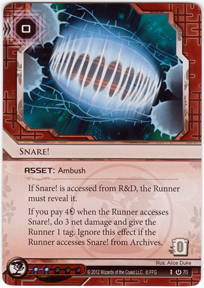 However, coming up with good probabilities is hard (if not impossible), this is a lot of mental math to do, and we’ve got a time limit in this game. So instead, we’ll try to do a more shorthand form of this. We’ll see how many of his traps and agendas he has played so far and make a guess based on that. So let’s say that we’ve seen two of his Edge of the Worlds already, but none of his snares, and he has about half his deck left. So we suspect that the odds of it being an Edge of the World are fairly low, but the odds of it being a Snare are much higher. And the odds of it being an agenda are also fairly high. If we run into an agenda, we likely win the game, if we run into a Snare it’s kinda bad, but if we run into the last copy of Edge of the World, it will really hurt. So we balance the risk versus the rewards and take a guess. Since we can’t assign real percentages to everything, there’s no real right guess here, you kind of just have to trust your gut. (Which just seems poetic and right when there are bluffs involved.)
However, coming up with good probabilities is hard (if not impossible), this is a lot of mental math to do, and we’ve got a time limit in this game. So instead, we’ll try to do a more shorthand form of this. We’ll see how many of his traps and agendas he has played so far and make a guess based on that. So let’s say that we’ve seen two of his Edge of the Worlds already, but none of his snares, and he has about half his deck left. So we suspect that the odds of it being an Edge of the World are fairly low, but the odds of it being a Snare are much higher. And the odds of it being an agenda are also fairly high. If we run into an agenda, we likely win the game, if we run into a Snare it’s kinda bad, but if we run into the last copy of Edge of the World, it will really hurt. So we balance the risk versus the rewards and take a guess. Since we can’t assign real percentages to everything, there’s no real right guess here, you kind of just have to trust your gut. (Which just seems poetic and right when there are bluffs involved.)
Unorthodox advancing
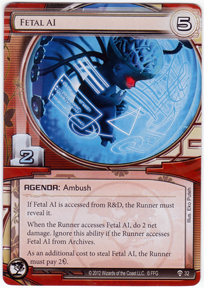 As a final point, this entire article is based on the use of fairly normal patterns people use to advance agendas, such as installing a 3-cost agenda on one turn and scoring it next turn, or installing a 5-cost agenda and putting two tokens on it in one turn and scoring it on the next turn. These normal methods of advancing agendas are in place for good reason; they expose your agendas to the opponent for the fewest turns possible, making it harder to steal them.
As a final point, this entire article is based on the use of fairly normal patterns people use to advance agendas, such as installing a 3-cost agenda on one turn and scoring it next turn, or installing a 5-cost agenda and putting two tokens on it in one turn and scoring it on the next turn. These normal methods of advancing agendas are in place for good reason; they expose your agendas to the opponent for the fewest turns possible, making it harder to steal them.
If you play all of your traps AND agendas in strange ways, lackadaisically putting tokens on them here and there, then sure, you’re bluffing your opponent well by playing your traps and agendas in the same way, but there’s going to be more times when you have agendas with one or two tokens on them which your opponent can decide that they’ll only run whenever they have the protection. And since you’re stretching the game out by leaving things in play longer than they normally would be, you really aren’t in a place to take advantage of the fact that they are being so slow and cautious. (And really, the Corp can make things dangerous for themselves by playing too slowly, as they’ll have more chances to draw agendas they have to protect.
But if you DO regularly leave advanced agendas sitting around for multiple turns before scoring them and kill your opponents off with five-token Project Junebugs, you might want to get into poker. I think you’d do well there.
The Great Unmentionable
We have offshored both our consumption and our perceptions
By George Monbiot, published on the Guardian’s website, 12th April 2013
Every society has topics it does not discuss. These are the issues which challenge its comfortable assumptions. They are the ones that remind us of mortality, which threaten the continuity we anticipate, which expose our various beliefs as irreconcilable.
Among them are the facts which sink the cosy assertion, that (in David Cameron’s words) “there need not be a tension between green and growth.”
At a reception in London recently I met an extremely rich woman, who lives, as most people with similar levels of wealth do, in an almost comically unsustainable fashion: jetting between various homes and resorts in one long turbo-charged holiday. When I told her what I did, she responded, “oh I agree, the environment is so important. I’m crazy about recycling.” But the real problem, she explained, was “people breeding too much”.
I agreed that population is an element of the problem, but argued that consumption is rising much faster and – unlike the growth in the number of people – is showing no signs of levelling off. She found this notion deeply offensive: I mean the notion that human population growth is slowing. When I told her that birth rates are dropping almost everywhere, and that the world is undergoing a slow demographic transition, she disagreed violently: she has seen, on her endless travels, how many children “all those people have”.
As so many in her position do, she was using population as a means of disavowing her own impacts. The issue allowed her to transfer responsibility to other people: people at the opposite end of the economic spectrum. It allowed her to pretend that her shopping and flying and endless refurbishments of multiple homes are not a problem. Recycling and population: these are the amulets people clasp in order not to see the clash between protecting the environment and rising consumption.
In a similar way, we have managed, with the help of a misleading global accounting system, to overlook one of the gravest impacts of our consumption. This too has allowed us to blame foreigners – particularly poorer foreigners – for the problem.
When nations negotiate global cuts in greenhouse gas emissions, they are held responsible only for the gases produced within their own borders. Partly as a result of this convention, these tend to be the only ones that countries count. When these “territorial emissions” fall, they congratulate themselves on reducing their carbon footprints. But as markets of all kinds have been globalised, and as manufacturing migrates from rich nations to poorer ones, territorial accounting bears ever less relationship to our real impacts.
While this is an issue which affects all post-industrial countries, it is especially pertinent in the United Kingdom, where the difference between our domestic and international impacts is greater than that of any other major emitter. The last government boasted that this country cut greenhouse gas emissions by 19% between 1990 and 2008. It positioned itself (as the current government does) as a global leader, on course to meet its own targets, and as an example for other nations to follow.
But the cut the UK has celebrated is an artefact of accountancy. When the impact of the goods we buy from other nations is counted, our total greenhouse gases did not fall by 19% between 1990 and 2008. They rose by 20%. This is despite the replacement during that period of many of our coal-fired power stations with natural gas, which produces roughly half as much carbon dioxide for every unit of electricity. When our “consumption emissions”, rather than territorial emissions, are taken into account, our proud record turns into a story of dismal failure.
There are two further impacts of this false accounting. The first is that because many of the goods whose manufacture we commission are now produced in other countries, those places take the blame for our rising consumption. We use China just as we use the population issue: as a means of deflecting responsibility. What’s the point of cutting our own consumption, a thousand voices ask, when China is building a new power station every 10 seconds (or whatever the current rate happens to be)?
But, just as our position is flattered by the way greenhouse gases are counted, China’s is unfairly maligned. A graph published by the House of Commons Energy and Climate Change Committee shows that consumption accounting would reduce China’s emissions by roughly 45%. Many of those power stations and polluting factories have been built to supply our markets, feeding an apparently insatiable demand in the UK, the US and other rich nations for escalating quantities of stuff.
The second thing the accounting convention has hidden from us is consumerism’s contribution to global warming. Because we consider only our territorial emissions, we tend to emphasise the impact of services – heating, lighting and transport for example – while overlooking the impact of goods. Look at the whole picture, however, and you discover (using the Guardian’s carbon calculator) that manufacturing and consumption is responsible for a remarkable 57% of the greenhouse gas production caused by the UK.
Unsurprisingly, hardly anyone wants to talk about this, as the only meaningful response is a reduction in the volume of stuff we consume. And this is where even the most progressive governments’ climate policies collide with everything else they represent. As Mustapha Mond points out in Brave New World, “industrial civilization is only possible when there’s no self-denial. Self-indulgence up to the very limits imposed by hygiene and economics. Otherwise the wheels stop turning”.
The wheels of the current economic system – which depends on perpetual growth for its survival – certainly. The impossibility of sustaining this system of endless, pointless consumption without the continued erosion of the living planet and the future prospects of humankind, is the conversation we will not have.
By considering only our territorial emissions, we make the impacts of our escalating consumption disappear in a puff of black smoke: we have offshored the problem, and our perceptions of it.
But at least in a couple of places the conjuring trick is beginning to attract some attention.
On April 16th, the Carbon Omissions site will launch a brilliant animation by Leo Murray, neatly sketching out the problem*. The hope is that by explaining the issue simply and engagingly, his animation will reach a much bigger audience than articles like the one you are reading can achieve.
(*Declaration of interest (unpaid): I did the voiceover).
On April 24th, the Committee on Climate Change (a body that advises the UK government) will publish a report on how consumption emissions are likely to rise, and how government policy should respond to the issue.
I hope this is the beginning of a conversation we have been avoiding for much too long. How many of us are prepared fully to consider the implications?
www.monbiot.com
How many unique English tweets are possible? How long would it take for the population of the world to read them all out loud?
—Eric H., Hopatcong, NJ
High up in the North in the land called Svithjod, there stands a rock. It is a hundred miles high and a hundred miles wide. Once every thousand years a little bird comes to this rock to sharpen its beak. When the rock has thus been worn away, then a single day of eternity will have gone by.
Tweets are 140 characters long. There are 26 letters in English—27 if you include spaces. Using that alphabet, there are \( 27^{140} \approx 10^{200} \) possible strings.
But Twitter doesn't limit you to those characters. You have all of Unicode to play with, which has room for over a million different characters. The way Twitter counts Unicode characters is complicated, but the number of possible strings could be as high as \( 10^{800} \).
Of course, almost all of them would be meaningless jumbles of characters from a dozen different languages. Even if you're limited to the 26 English letters, the strings would be full of meaningless jumbles like "ptikobj". Eric's question was about tweets that actually say something in English. How many of those are possible?
This is a tough question. Your first impulse might be to allow only English words. Then you could further restrict it to grammatically valid sentences.
But it gets tricky. For example, “Hi, I’m Mxyztplk” is a grammatically valid sentence if your name happens to be Mxyztplk. (Come to think of it, it’s just as grammatically valid if you’re lying.) Clearly, it doesn’t make sense to count every string that starts with “Hi, I’m ...” as a separate sentence. To a normal English speaker, “Hi, I’m Mxyztplk” is basically indistinguishable from “Hi, I’m Mxzkqklt”, and shouldn't both count. But “Hi, I’m xPoKeFaNx” is definitely recognizably different from the first two, even though “xPoKeFaNx” isn’t an English word by any stretch of the imagination.
Fortunately, there’s a better approach.
Let’s imagine a language which has only two valid sentences, and every tweet must be one of the two sentences. They are:
- “There’s a horse in aisle five.”
- “My house is full of traps.”
Twitter would look like this:

The messages are relatively long, but there’s not a lot of information in each one—all they tell you is whether the person decided to send the trap message or the horse message. It’s a 1 or a 0. Although there are a lot of letters, for a reader who knows the pattern the language carries only one bit of information per sentence.
This example hints at a very deep idea, which is that information is fundamentally tied to the recipient’s uncertainty about the message’s content and their ability to predict it in advance.
Claude Shannon—who almost singlehandedly invented modern information theory—had a clever method for measuring the information content of a language. He showed groups of people samples of typical written English which were cut off at a random point, then asked them to guess which letter came next.

Based on the rates of correct guesses—and rigorous mathematical analysis—Shannon determined that the information content of typical written English was around 1.0 to 1.2 bits per letter. This means that a good compression algorithm should be able to compress ASCII English text—which is eight bits per letter—to about 1/8th of its original size. Indeed, if you use a good file compressor on a .txt ebook, that’s about what you’ll find.
If a piece of text contains n bits of information, in a sense it means that there are \( 2^n \) different messages it can convey. There’s a bit of mathematical juggling here (involving, among other things, the length of the message and the concept of unicity distance), but the bottom line is that it suggests there are on the order of about \( 2^{140\times1.1} \approx 2\times10^{46} \) meaningfully different English tweets, rather than \( 10^{200} \) or \( 10^{800} \).
Now, how long would it take the world to read them all out?
Reading \( 2\times10^{46} \) tweets would take a person nearly \( 10^{47} \) seconds. It’s such a staggeringly large number of tweets that it hardly matters whether it’s one person reading or a billion—they won’t be able to make a meaningful dent in the list in the lifetime of the Earth.
Instead, let’s think back to that bird sharpening its beak on the mountaintop. Suppose that the bird scrapes off a tiny bit of rock from the mountain when it visits every thousand years, and it carries away those few dozen dust particles when it leaves. (A normal bird would probably deposit more beak material on the mountaintop than it would wear away, but virtually nothing else about this scenario is normal either, so we’ll just go with it.)
Let’s say you read tweets aloud for 16 hours a day, every day. And behind you, every thousand years, the bird arrives and scrapes off a few invisible specks of dust from the top of the hundred-mile mountain with its beak.
When the mountain is worn flat to the ground, that’s the first day of eternity.
The mountain reappears and the cycle starts again for another eternal day. 365 eternal days—each one \( 10^{32} \) years long—makes an eternal year.

100 eternal years, in which the bird grinds away 36,500 mountains, make an eternal century.
But a century isn’t enough. Nor a millennium.
Reading all the tweets takes you ten thousand eternal years.
That’s enough time to watch all of human history unfold, from the invention of writing to the present, with each day lasting as long as it takes for the bird to wear down a mountain.
140 characters may not seem like a lot, but we will never run out of things to say.

The key to getting motivated: give up
A guest post I wrote for 99u.com:
The real problem isn’t that you don’t feel like taking action. Rather, it’s the underlying assumption that you need to feel like taking action before you can act.
You can read the whole thing here.






